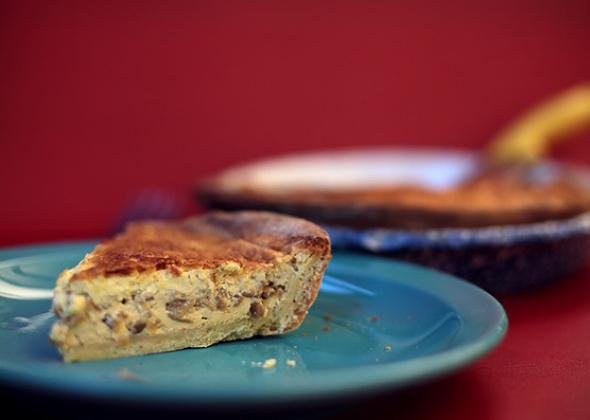For most of my life, I’ve thought of quiche as frittata with crust—which is to say savory egg pie. Since frittata is incredibly easy and delicious, and pie crust is not an exciting pastry, I’ve generally made lots and lots of frittatas and not very many quiches.
But a few months ago, I discovered how very wrong I was about quiche when Slate’s chairman brought me a square of caramelized-onion quiche from his new favorite bakery, Arcade Bakery in Tribeca. It tasted nothing like a frittata: Instead of being eggy and sturdy, the filling was moist and creamy to the point of silkiness. It was simultaneously light—the filling practically dissolved on my tongue—and rich, like a triple-crème brie or an over-the-top chocolate mousse. As I luxuriated in each bite at my desk in the middle of Slate’s open-plan office, I resented that my surroundings were unworthy of this gastronomic experience—this was a quiche worthy of a picnic in Provence, or at least an intimate dinner party.
Eager to learn the key to this delicacy, I reached out to Roger Gural, the owner of Arcade Bakery, to ask for his recipe, which he kindly shared. His approach is unusual in some ways—for instance, he adds yeast to his pie dough, which gives it a breadier exterior and a more interesting flavor than traditional pâte brisée.
But the secret to Gural’s amazing quiche isn’t really a secret at all: It turns out quiche isn’t primarily an egg dish; it’s primarily a cream and milk dish. Quiche filling should contain just enough eggs to prevent it from being soupy, but the eggs are (literally) a supporting player. It’s the butterfat in the cream and milk that is responsible for a good quiche’s disarmingly rich texture. In other words: Quiche isn’t frittata with crust; it’s savory custard with crust. (This is why it needs a crust—without it, the custard would fall apart and look gross when you tried to serve it.)
The recipe below is lightly adapted from Gural’s; some proportions changed ever so slightly in the transition from metric to conventional American measurements, and I used a standard round pie plate instead of Arcade Bakery’s rectangular mold. I also streamlined the crust, but if you don’t have the time to wait for a yeasted dough to rise, you can substitute a standard pie crust. You can also skip the caramelized onions to save time, or substitute other fillings, as long as they’re fairly dry—excess liquid will ruin the filling’s texture, which is, after all, the most important part.
Caramelized Onion Quiche
Adapted from Arcade Bakery
Yield: 6 to 8 servings
Time: 2½ to 4½ hours, largely unattended
6 tablespoons (¾ stick) cold unsalted butter
2 medium yellow onions, thinly sliced
Salt and black pepper
1¼ cups all-purpose flour, plus more for rolling out the crust
1 tablespoon sugar
½ teaspoon instant yeast
3 large eggs plus 4 large egg yolks
1¼ cups plus 1 tablespoon whole milk
1¼ cups heavy cream
1. Put 2 tablespoons (¼ stick) of the butter in a large skillet over medium-low heat. When the butter melts, add the onions, season with salt and pepper, and cook, stirring occasionally, until thick and dark brown, 1 to 3 hours.
2. Meanwhile, combine the flour, sugar, yeast, and ½ teaspoon salt in a large bowl. Stir in 1 of the eggs, 1 tablespoon of the milk, and 2 tablespoons water, and knead with the dough-hook attachment of a stand mixer or by hand until the dough feels smooth and elastic, about 10 minutes. Cut the remaining ¼ cup (½ stick) of the butter into ½-inch pieces, add it to the dough, and continue to knead until the butter is fully incorporated. Cover the bowl with a clean kitchen towel or plastic wrap, put it in a warm place, and let the dough rise for 1 hour. (At this point you can wrap the dough in foil or plastic wrap and refrigerate for up to 2 days.)
3. Heat the oven to 350°F. Put the remaining 2 eggs and 4 egg yolks in a large bowl and whisk to combine. Add the remaining 1¼ cups milk, the cream, ¾ teaspoon salt, and a pinch of black pepper. Whisk to combine.
4. Place the dough on a lightly floured surface. With a rolling pin, roll out the dough until it’s approximately 11 inches in diameter. Transfer the dough to a 9-inch pie plate; trim any dough that hangs over the edges of the plate and discard the scraps. Spread the onions evenly on the crust, then pour the egg mixture over the onions. Bake until the quiche wobbles slightly in the center when shaken but is no longer liquid, 45 minutes to 1 hour. Let the quiche cool for at least 15 minutes before slicing and serving. (Store leftover quiche in an airtight container in the refrigerator for up to a few days.)
Previously in You’re Doing It Wrong:
Rolls
Clafoutis
Cheese
Pie
Frittata
